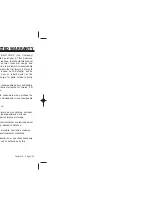
5. What research is needed to decide whether RF exposure
from wireless phones poses a health risk?
A combination of laboratory studies and epidemiological studies of
people actually using wireless phones would provide some of the
data that are needed. Lifetime animal exposure studies could be
completed in a few years. However, very large numbers of animals
would be needed to provide reliable proof of a cancer promoting
effect if one exists. Epidemiological studies can provide data that is
directly applicable to human populations, but 10 or more years’ fol-
low-up may be needed to provide answers about some health
effects, such as cancer. This is because the interval between the
time of exposure to a cancer-causing agent and the time tumors
develop - if they do - may be many, many years. The interpretation
of epidemiological studies is hampered by difficulties in measuring
actual RF exposure during day-to-day use of wireless phones.
Many factors affect this measurement, such as the angle at which
the phone is held, or which model of phone is used.
6. What is FDA doing to find out more about the possible
health effects of wireless phone RF?
FDA is working with the U.S. National Toxicology Program and with
groups of investigators around the world to ensure that high priori-
ty animal studies are conducted to address important questions
about the effects of exposure to radiofrequency energy (RF).
FDA has been a leading participant in the World Health
Organization International Electromagnetic Fields (EMF) Project
since its inception in 1996. An influential result of this work has
been the development of a detailed agenda of research needs that
has driven the establishment of new research programs around
the world. The Project has also helped develop a series of public
information documents on EMF issues.
FDA and the Cellular Telecommunications & Internet Association
(CTIA) have a formal Cooperative Research and Development
Agreement (CRADA) to do research on wireless phone safety.
FDA provides the scientific oversight, obtaining input from experts
in government, industry, and academic organizations. CTIA-fund-
ed research is conducted through
Chapter 5 - Page 135
Commission safety guidelines that were developed with the advice
of FDA and other federal health and safety agencies. When the
phone is located at greater distances from the user, the exposure
to RF is drastically lower because a person’s RF exposure
decreases rapidly with increasing distance from the source. The
so-called “cordless phones,” which have a base unit connected to
the telephone wiring in a house, typically operate at far lower power
levels, and thus produce RF exposures far below the FCC safety
limits.
4. What are the results of the research done already?
The research done thus far has produced conflicting results, and
many studies have suffered from flaws in their research methods.
Animal experiments investigating the effects of radiofrequency
energy (RF) exposures characteristic of wireless phones have
yielded conflicting results that often cannot be repeated in other
laboratories. A few animal studies, however, have suggested that
low levels of RF could accelerate the development of cancer in lab-
oratory animals. However, many of the studies that showed
increased tumor development used animals that had been geneti-
cally engineered or treated with cancer-causing chemicals so as to
be pre-disposed to develop cancer in the absence of RF exposure.
Other studies exposed the animals to RF for up to 22 hours per
day. These conditions are not similar to the conditions under which
people use wireless phones, so we don’t know with certainty what
the results of such studies mean for human health.
Three large epidemiology studies have been published since
December 2000. Between them, the studies investigated any pos-
sible association between the use of wireless phones and primary
brain cancer, glioma, meningioma, or acoustic neuroma, tumors of
the brain or salivary gland, leukemia, or other cancers. None of the
studies demonstrated the existence of any harmful health effects
from wireless phone RF exposures. However, none of the studies
can answer questions about long-term exposures, since the aver-
age period of phone use in these studies was around three years.
Page 134 - Chapter 5
CDM-8600verizon5-26 2003.5.26 3:9 PM Page 136
Содержание 8600 - Cell Phone - CDMA2000 1X
Страница 1: ......
Страница 9: ...e phone s basic functions evels and call functions Call pter 2 OPERATION Chapter 2 Page 15 ...
Страница 17: ...umerous functions including the internal phone book ng call logs mbers pter 3 MORY TTINGS Chapter 3 Page 31 ...
Страница 46: ...TINGS TINGS e SEND KEY with er mode ith y to answer an incoming call and to answer a call Chapter 3 Page 89 ...
Страница 58: ...Chapter 3 Page 113 CE SVC E SVC ACTIVE FLIP with ...
Страница 59: ...sing your handset to access the ser pter 4 ERNET OWSER Chapter 4 Page 115 ...
Страница 60: ...ER MENU ER MENU enu press Select age press mark list press S press ss Chapter 4 Page 117 ...
Страница 62: ...or Wireless Handheld Phones or FCC RF Exposure date pter 5 FETY RMATION Chapter 5 Page 121 ...
Страница 72: ...nty Warranty pter 6 RRANTY Chapter 6 Page 141 ...






































